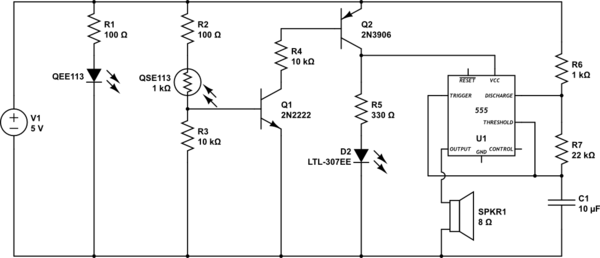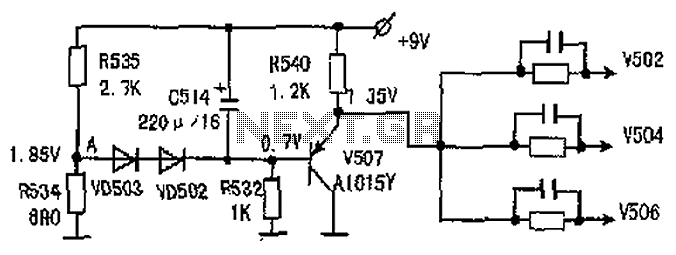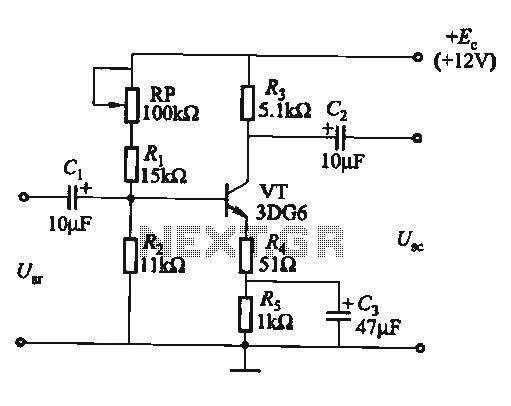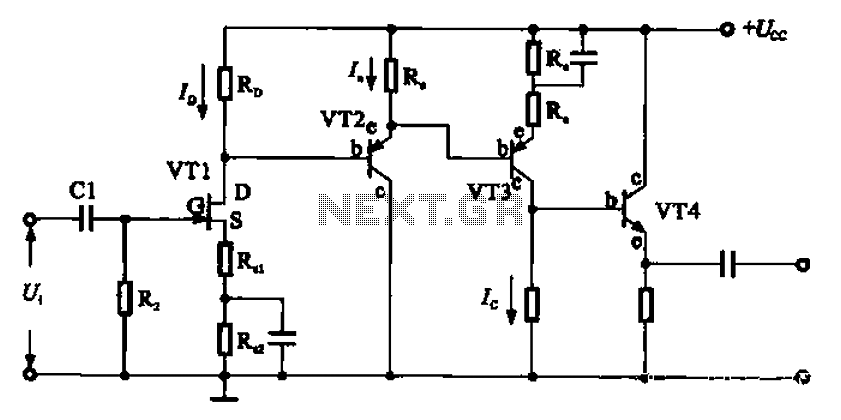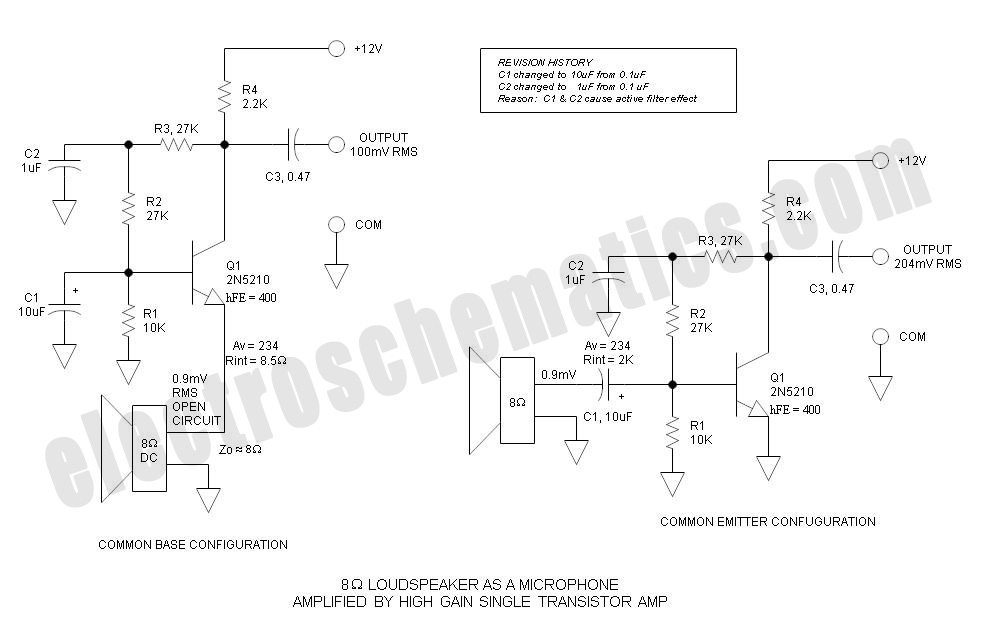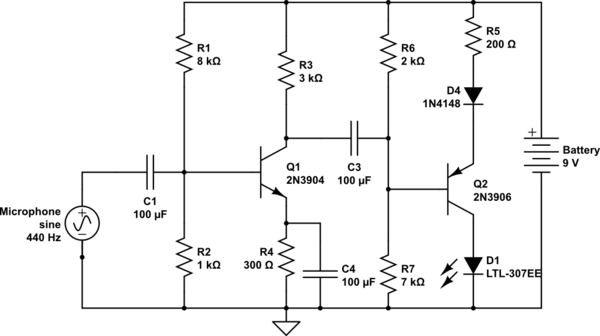
ir emitter 38khz

A 555-based oscillator has been constructed to drive an infrared (IR) LED at a frequency of 38 kHz. The circuit has been assembled, and measurements confirm the generation of a 38 kHz signal. A modulated IR receiver, specifically from Radio Shack and set to 38 kHz, has been integrated into the setup. Functionality has been verified by using a TV remote control, which successfully activates a red LED connected to the receiver's output pin. The LED flashes in response to the remote, particularly when the receiver is moved horizontally. The circuit is built on breadboards, with attention given to ensuring there are no loose connections. A 5V power source from a selectable voltage wall wart is connected to a 7805 voltage regulator, accompanied by a couple of capacitors for stability. An observation was made regarding the timing capacitor: shorting its pins with a finger causes the receiving LED to illuminate briefly, indicating some level of functionality. The specifics of the IR receiver circuit are not available at the moment, but it will be provided later. Uncertainty exists regarding whether the red LED is connected to ground or +5V. The IR receiver is directly linked to ground and the +5V rails. A 1k resistor is connected from the output pin to the red LED to signal the presence of an IR signal. Questions arise about whether all modulated IR receivers possess an automatic gain control (AGC) mechanism, especially in light of various pulsed IR LED circuits for obstacle avoidance. The output high of the 555 timer is measured at +3.6V when supplied with +5.0V. The voltage across the IR LED is approximately 1.3V, leaving 2.3V across a 470-ohm current-limiting resistor, resulting in a current of roughly 4.9 mA. Most IR receiver ICs are designed to decrease their gain when detecting continuous 38 kHz signals, such as those from compact fluorescent bulbs, while maximizing gain during data bursts. Replacing the 470-ohm resistor in the IR sender with a 39-ohm resistor would increase the current pulses in the IR LED to about 52 mA, enhancing its range. The datasheet for typical IR receivers indicates a resistor supplying +5V and a capacitor to ground are essential for proper operation. Upon further inspection, a 120-ohm resistor was found to be in use instead of the recommended 470-ohm resistor. The wall wart is set to 9V, and the 7805 regulator outputs a steady 5V. There is a belief that the gain issue previously mentioned is affecting performance. Moving a hand over both the emitter and receiver results in the LED connected to the receiver lighting up momentarily before extinguishing, suggesting that brief signals may suffice for certain applications, such as driving a relay or controlling a robot's direction. The IR receiver module in use is the 38 kHz Infrared Receiver Module available at Radio Shack. Further modifications to the circuit are planned to enhance understanding of the 555 timer's functionality.
The circuit utilizes a 555 timer configured in astable mode to generate a square wave output at 38 kHz, suitable for driving the IR LED. The 555 timer's output is connected to the anode of the IR LED, while the cathode is connected through a current-limiting resistor to ground. The choice of the resistor value is critical; a lower resistance allows for higher current through the LED, thus increasing its output power and range. The IR receiver is designed to detect the modulated IR signals, and its output is connected to a red LED through a 1k resistor to indicate when a signal is received. The receiver's gain characteristics are influenced by the nature of the incoming signal, with AGC mechanisms allowing for optimal sensitivity during bursts of data while reducing sensitivity to continuous signals.
The power supply circuit is essential for stable operation; the 7805 voltage regulator ensures that the circuit receives a consistent 5V from the 9V wall wart, with bypass capacitors placed close to the regulator to filter out noise. The timing capacitor in the 555 circuit influences the duty cycle of the output signal; careful selection of capacitor and resistor values will determine the frequency and pulse width of the output signal.
Testing and troubleshooting this circuit may involve experimenting with different resistor values for both the IR LED and the timing capacitor to achieve desired performance characteristics. Additionally, ensuring all connections are secure and verifying the integrity of components will contribute to the overall reliability of the circuit. The insights gained from this project may enhance understanding of IR communication principles and the operation of the 555 timer in various applications.I`ve built a 555 based oscillator to drive ir led at 38khz. I`ve got the circuit wired up and I`ve used my meter on the duty setting to read that it is indeed generated a 38khz signal. I`ve also wired up a modulated IR receiver, the one from radio shack set to 38khz. I`ve verified it`s working by pointing my TV remote at it. I`ve hooked up a red l ed to the output pin of the receiver and it lights up and flashes when I do this. The red led lights up occasionally especially if I move the receiver back and forth horzontally. I`ve checked for loose wires [this is all on a couple of bread boards], the led always lights up when I blast it with my remote. Oh I`m using a 5v source from a wall wart [the radioshack one that you can select the output voltage for] connected to a 7805 with a couple of capacitors.
The power source circuit i bought and soldered together, it fits standard breadboards [solar-robotics] so hopefully its okay. One thing I did notice is on the timing capacitor, if I short the two pins of the capacitor with my finger, the receiving led lights up as if its working fora second or two then goes out.
This works if I repeat the process touching the capacitor. I`m at work and don`t have the IR receiver circuit handy but I`ll post it when I get home. I don`t recal if I`m connecting the red led to ground or to +5V. The IR receiver itself is directly connected to ground and the +5V rails. I have a 1k resistor connected from the output pin to a regular red LED to indicat the presence of a signal. Do all modulated IR receivers have a auto gain mechanism I`ve seen so many of these little pulsed IR led circuits for simple obstacle avoidance that I`m beginning to wonder if I`ve missed something totally or my receiver just isn`t designed for my intended purpose.
The output high of the 555 is only +3. 6V if its power supply is +5. 0V. The voltage across the IR LED is about 1. 3V so the remaining 2. 3V is across the 470 ohm current-limiting resistor which gives a current of only 2. 3V/470 ohms= 4. 9mA. Most IR rerceiver ICs are designed to reduce their gain when they detect continuous 38kHz from a compact fluorescent light bulb. Their gain is at max when the IR pulses are in bursts of data. If you replace the 470 ohm current-limiting resistor in your IR sender with 39 ohms then the current pulses in the IR LED will be about 52mA and the range will be much more.
The datasheet for most IR receivers show a resistor feeding +5V to it then a capacitor to ground. It won`t work properly without the resistor and capacitor. Here is an IR receiver circuit from Vishay`s datasheet: I checked when I got home this evening and I happen to be using a 120 ohm resistor instead of the specified 470 ohm resistor. My wall wart is set to 9V, and the 7805 is putting out a steady 5 Volt. At this point I think its the gain issue that people mentioned earlier in the thread. If I move my hand over both the emitter and receiver [both point up], the led lights up [the led connected to the receiver], connected to the receiver for a second then it goes out.
This is repeatable. Not sure where this leaves me, perhaps the brief signal is all the train guy needs to drive a relay or for a little robot to reverse direction or turn right etc. Ok so its the AGC. Winson the Ir receiver I am using is from Radio shack, they only sell one type AFAIK. 38kHz Infrared (IR) Receiver Module - RadioShack. com Audioguru - Thanks for you response and your suggestions are good I will attempt to modify the circuit as you specified.
Will make me more familiar with the 555 in any event! 🔗 External reference
The circuit utilizes a 555 timer configured in astable mode to generate a square wave output at 38 kHz, suitable for driving the IR LED. The 555 timer's output is connected to the anode of the IR LED, while the cathode is connected through a current-limiting resistor to ground. The choice of the resistor value is critical; a lower resistance allows for higher current through the LED, thus increasing its output power and range. The IR receiver is designed to detect the modulated IR signals, and its output is connected to a red LED through a 1k resistor to indicate when a signal is received. The receiver's gain characteristics are influenced by the nature of the incoming signal, with AGC mechanisms allowing for optimal sensitivity during bursts of data while reducing sensitivity to continuous signals.
The power supply circuit is essential for stable operation; the 7805 voltage regulator ensures that the circuit receives a consistent 5V from the 9V wall wart, with bypass capacitors placed close to the regulator to filter out noise. The timing capacitor in the 555 circuit influences the duty cycle of the output signal; careful selection of capacitor and resistor values will determine the frequency and pulse width of the output signal.
Testing and troubleshooting this circuit may involve experimenting with different resistor values for both the IR LED and the timing capacitor to achieve desired performance characteristics. Additionally, ensuring all connections are secure and verifying the integrity of components will contribute to the overall reliability of the circuit. The insights gained from this project may enhance understanding of IR communication principles and the operation of the 555 timer in various applications.I`ve built a 555 based oscillator to drive ir led at 38khz. I`ve got the circuit wired up and I`ve used my meter on the duty setting to read that it is indeed generated a 38khz signal. I`ve also wired up a modulated IR receiver, the one from radio shack set to 38khz. I`ve verified it`s working by pointing my TV remote at it. I`ve hooked up a red l ed to the output pin of the receiver and it lights up and flashes when I do this. The red led lights up occasionally especially if I move the receiver back and forth horzontally. I`ve checked for loose wires [this is all on a couple of bread boards], the led always lights up when I blast it with my remote. Oh I`m using a 5v source from a wall wart [the radioshack one that you can select the output voltage for] connected to a 7805 with a couple of capacitors.
The power source circuit i bought and soldered together, it fits standard breadboards [solar-robotics] so hopefully its okay. One thing I did notice is on the timing capacitor, if I short the two pins of the capacitor with my finger, the receiving led lights up as if its working fora second or two then goes out.
This works if I repeat the process touching the capacitor. I`m at work and don`t have the IR receiver circuit handy but I`ll post it when I get home. I don`t recal if I`m connecting the red led to ground or to +5V. The IR receiver itself is directly connected to ground and the +5V rails. I have a 1k resistor connected from the output pin to a regular red LED to indicat the presence of a signal. Do all modulated IR receivers have a auto gain mechanism I`ve seen so many of these little pulsed IR led circuits for simple obstacle avoidance that I`m beginning to wonder if I`ve missed something totally or my receiver just isn`t designed for my intended purpose.
The output high of the 555 is only +3. 6V if its power supply is +5. 0V. The voltage across the IR LED is about 1. 3V so the remaining 2. 3V is across the 470 ohm current-limiting resistor which gives a current of only 2. 3V/470 ohms= 4. 9mA. Most IR rerceiver ICs are designed to reduce their gain when they detect continuous 38kHz from a compact fluorescent light bulb. Their gain is at max when the IR pulses are in bursts of data. If you replace the 470 ohm current-limiting resistor in your IR sender with 39 ohms then the current pulses in the IR LED will be about 52mA and the range will be much more.
The datasheet for most IR receivers show a resistor feeding +5V to it then a capacitor to ground. It won`t work properly without the resistor and capacitor. Here is an IR receiver circuit from Vishay`s datasheet: I checked when I got home this evening and I happen to be using a 120 ohm resistor instead of the specified 470 ohm resistor. My wall wart is set to 9V, and the 7805 is putting out a steady 5 Volt. At this point I think its the gain issue that people mentioned earlier in the thread. If I move my hand over both the emitter and receiver [both point up], the led lights up [the led connected to the receiver], connected to the receiver for a second then it goes out.
This is repeatable. Not sure where this leaves me, perhaps the brief signal is all the train guy needs to drive a relay or for a little robot to reverse direction or turn right etc. Ok so its the AGC. Winson the Ir receiver I am using is from Radio shack, they only sell one type AFAIK. 38kHz Infrared (IR) Receiver Module - RadioShack. com Audioguru - Thanks for you response and your suggestions are good I will attempt to modify the circuit as you specified.
Will make me more familiar with the 555 in any event! 🔗 External reference
